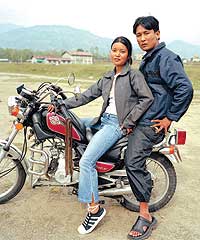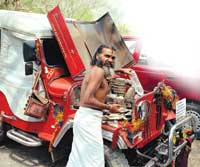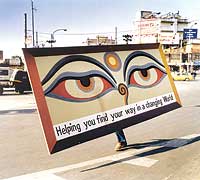 Eighteen remarkable portraits taken in Nepal in 2003 by William Mebane, an American photographer and visiting Fulbright Scholar, are on display at Siddhartha Art Gallery, Baber Mahal Revisited. The individuals in these large sized colour photos look directly at the photographer and the viewer. The people seen here speak for themselves through facial expressions, bodily gestures and the clothes they wear.
Eighteen remarkable portraits taken in Nepal in 2003 by William Mebane, an American photographer and visiting Fulbright Scholar, are on display at Siddhartha Art Gallery, Baber Mahal Revisited. The individuals in these large sized colour photos look directly at the photographer and the viewer. The people seen here speak for themselves through facial expressions, bodily gestures and the clothes they wear.
Mebane, who characterises himself as a "street photographer" went out on the streets of Kathmandu, Pokhara and other Nepali towns to meet and engage his potential subjects. He was not looking for the "decisive moment" that captures a person or an action as it is happening. Instead, he is drawn to the person, his or her persona or presence, hopefully revealed through the photographer's lens in an unguarded and willing fashion.
On the rare occasions when Mebane fails, the photo bears the indelible feel of a studio portrait. When he succeeds, as he most often does, the individuals, with expressions and gestures and with the clothes they wear, step out of the photograph with an intensity that says this is who I am, this is who we are, this is how I want to be seen. Or sometimes, more naturally, this is the person you would see if you happened to come by just now without a camera in hand wanting to take my photo.  In a powerful and uncompromising way, the young girls in "Three Hip Hop Girls, Dragon World, Kathmandu" and the young men in "Three Young Men, Lakeside, Pokhara" present both the trappings of pop culture and the reality of being young. These teenagers define themselves by their dress and bearing. The boys are at ease with their pose while the young girls are more defiant and more guarded. In "Learning to Drive a Motorcycle, Pokhara" (top, left) a young woman and man on the bike seem comfortable with each other, yet apart and sure of themselves. They are not defiantly being young, but they are out on their own, and their dress and bearing speak of their lifestyle and free spirit.
In a powerful and uncompromising way, the young girls in "Three Hip Hop Girls, Dragon World, Kathmandu" and the young men in "Three Young Men, Lakeside, Pokhara" present both the trappings of pop culture and the reality of being young. These teenagers define themselves by their dress and bearing. The boys are at ease with their pose while the young girls are more defiant and more guarded. In "Learning to Drive a Motorcycle, Pokhara" (top, left) a young woman and man on the bike seem comfortable with each other, yet apart and sure of themselves. They are not defiantly being young, but they are out on their own, and their dress and bearing speak of their lifestyle and free spirit.
In "Sadhu Putting Water Into His Jeep, Mugling" (right) the irresistible sadhu appears to be more man of the world than ascetic, his jeep more necessary for his trade than a trident or begging bowl.
The man in "Man Breaking Rocks For Gravel, Hemza, Pokhara" sits with his tool in hand midst the rocks he is breaking down into gravel. He appears to be as self-contained as a statue. His body is still, but his eyes and his face seem ready to break open like the rocks he shatters. Is the T-shirt beneath his vest a token of modernity, and is his labour, his exploitation, a necessary underpinning for the modern world?
Mebane in these few portraits presents a Nepal that he characterises as "caught up in the push and pull of tradition and modern life". He senses individuals claiming identities uniquely their own beneath the trappings and signs of pop culture. Were he to widen his gaze and recognise the situation and the difficult dignity of those like the "Man Breaking Rocks For Gravel", his skills and aesthetic sensibility would unearth not just a changing world, but an unchanging one. A world where individuality is not proclaimed by clothes worn or lifestyle adopted, but by the situation one bears.
(Wayne Amzits is a poet, photographer and long-time resident of Nepal.)
Portraits of Modern Life in Nepal by William Mebane, 13 June-4 July at Siddhartha Art Gallery, Baber Mahal Revisited.
 Myriad of paths
Myriad of paths Walking is a metaphor for life says photographer Ashok R Shakya of his latest exhibition at Park Gallery. "As in life, while walking, one finds ups and downs, going away and coming home," he believes. A French language teacher and a freelance photographer whose images have won international awards, Shakya's works have been published in magazines, calendars, brochures and postcards. Garuda magazine said, "his [Shakya's] photographs tend to make a balance between suffering and grace.His works often inspire a discreet spirituality."
Walking by Ashok R Shakya from 16-22 June at Park Gallery, Lazimpat. It moves to the Summit Hotel, Kupondole, from 24-30 June.
Courtesy: Mandala Book Point, Kantipath, 4227711, mandala@ccsl.com


